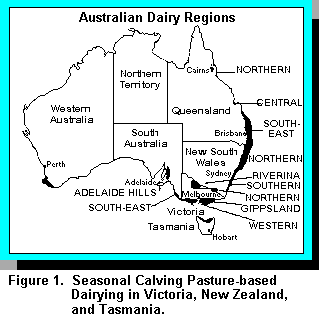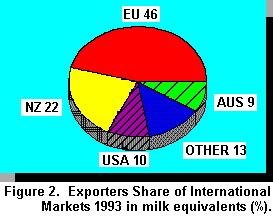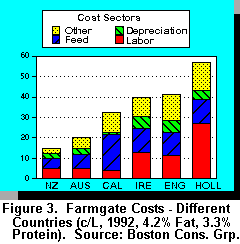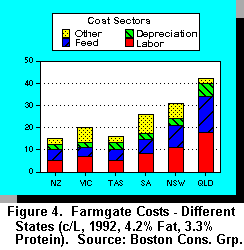Introduction
 Dairy farming in Australasia, that is Australia and New Zealand, is conducted under a wide range
of climatic conditions and under differing economic constraints. These factors make a simple
comparison with Canadian dairy farming misleading. Dairy production is largely confined to areas
which are favored by higher rainfall and better soils (Figure 1). Although each of the states in
Australia maintains its own dairy industry, the industry is dominated by the southern dairy
industry, in particular Victoria, which produces 62% of the total milk. Only 13% of the milk
produced in Victoria is used for whole milk consumption; the majority is used in the manufacture
of cheese, butter, and milk powder. Overall, only 27% of milk produced in Australia is diverted to
market milk.
The milk production characteristics of New Zealand are very similar to those of Victoria. Milk
production in Australasia, while small relative to world production, allows export of
approximately 31% of the world market (Figure 2) (1), the bulk coming from New Zealand.
Dependence on the world market ensures that there is a focus on a low cost of production,
although a better emphasis would be on cost-effective production. The relative efficiency of
production is indicated in Figure 3, which shows farmgate costs of production for the different
international dairy industries. Within this general framework, however, the states of New South
Wales (NSW), Western Australia (WA), and Queensland (QLD) which supply 80% or more of
production for whole milk consumption receive returns for market milk similar to those of
Canada. Figure 4 shows the different costs of production for the Australian states.
Dairy farming in Australasia, that is Australia and New Zealand, is conducted under a wide range
of climatic conditions and under differing economic constraints. These factors make a simple
comparison with Canadian dairy farming misleading. Dairy production is largely confined to areas
which are favored by higher rainfall and better soils (Figure 1). Although each of the states in
Australia maintains its own dairy industry, the industry is dominated by the southern dairy
industry, in particular Victoria, which produces 62% of the total milk. Only 13% of the milk
produced in Victoria is used for whole milk consumption; the majority is used in the manufacture
of cheese, butter, and milk powder. Overall, only 27% of milk produced in Australia is diverted to
market milk.
The milk production characteristics of New Zealand are very similar to those of Victoria. Milk
production in Australasia, while small relative to world production, allows export of
approximately 31% of the world market (Figure 2) (1), the bulk coming from New Zealand.
Dependence on the world market ensures that there is a focus on a low cost of production,
although a better emphasis would be on cost-effective production. The relative efficiency of
production is indicated in Figure 3, which shows farmgate costs of production for the different
international dairy industries. Within this general framework, however, the states of New South
Wales (NSW), Western Australia (WA), and Queensland (QLD) which supply 80% or more of
production for whole milk consumption receive returns for market milk similar to those of
Canada. Figure 4 shows the different costs of production for the Australian states.



These regions have highly predictable rainfall (32-38 inches) and a temperate climate that favors the growth of pastures of high digestibility (often greater than 70% digestible) containing high concentrations of crude protein (often greater than 25%). Compared to Canada in the winter, the climate is idyllic, god is in his heaven, and all is right with the world!
Dairy farming in these temperate regions is largely based on the need to harvest ryegrass (Lolium perenne) and clover (Trifolium sp) pastures. Detailed descriptions of the system have been provided by Trigg and Bryant (7), Wilson and Davey (8), Holmes and Macmillan (3), Holmes and Wilson (4), Lean (6), Kellaway and Porta (5).
Prevailing understandings of the production system drawn from these texts and others may be summarized as:
Key criteria that determine economic performance include
There is an increasing trend towards the use of supplementary feeds, especially in Victoria. It is likely that this trend will continue in the future as more sophisticated understandings of the pasture/ supplement interface are achieved. This change in supplementary feeding has lead to a decreased emphasis on production per hectare as the prime determinant of profit and increased emphasis on returns to capital, in New Zealand calculated as Effective Farm Surplus (see Table 2), (Click here to view Table 2). to determine economic efficiency. This Table also details average New Zealand performance. Tables 2 and 3 (Click here to view Table 3). provide some examples of EFS, from New Zealand and Victoria. It is interesting to note similarities between these and contrast them with the data from the New South Wales herd (Table 4). (Click here to view Table 4). The data comes from a herd where a sharemilker was employed and the wages have been adjusted to reflect the return to the enterprise after a standard labour component has been estimated.
Capital development on the farm in New Zealand, Victoria, and Tasmania is typically extremely low, with buildings associated with the farming enterprise limited to milking shed, often of very simple design, and a hay / machinery shed. Milking is very efficient, in terms of cows milked per labour unit per hour since milk yields per cow are relatively low. Rotary parlors and herringbone sheds are common and there is minimal udder preparation prior to milking. There is however, a marked increase in the capital costs of land in New Zealand, up to $NZ20,000 per acre, resulting in a high capital cost system with low variable costs.
The production efficiencies achieved through this system have resulted in an extremely low farm gate cost of production (see Figures 3 and 4). There are post-farm gate inefficiencies that result from the vast flood of milk that comes in spring and the relative paucity of milk in the winter. In particular, the investment in processing plants by dairy companies is substantial, to handle the spring surplus. These production systems tend to be supply- rather than demand-driven. Consequently, there is a great downward pressure on the value of the product which has to be sold on the world market where prices are low.
For the medium-sized farmer (150 cows), the major challenges include:
Some of these challenges result in a need to increase the number of cows milked. There are questions that need to be resolved about the optimal number of cows milked on pasture, since large numbers of cows can be difficult to manage on pasture.
These areas are greatly favored by their environment. They have the potential for very high producing herds with extremely low costs of production once there is an effective integration between the management of pasture and the management of supplementary feeds. Provided that world trade is conducted on a more equitable basis, in terms of a reduction in subsidies and non-tariff trade barriers, these areas will remain major centres for the export of dairy products.
Dairy Production in Non-seasonal Calving Areas of Australia (New South Wales, Queensland, Western Australia)
The dairy farming regions of NSW, QLD, and WA are less favored by predictable rainfall than the southern dairy industry and are more subject to drought. The industry is based more on whole milk sales and costs of production are higher than Victoria and New Zealand (see Table 4) (Click here to view Table 4). . Part of these higher costs, an estimated two to three cents per litre, is attributable to the need to produce whole milk over the entire year. To ensure that milk is available all year round, quota systems have been used to manage milk supply.
Milk production levels have increased rapidly over the past few years and NSW now has the highest producing cows in Australasia, with an average well over 5000 litres per cow and some herds with considerable pasture inputs exceeding 9000 litres over a 300 day lactation. It is interesting to note the similarities between costs of production in California with those in NSW (Figures 3 and 4). Total costs are very similar, but feed costs are lower in NSW. Labour costs are higher in NSW, undoubtedly because of the relatively low herd size. The average herd size in NSW is still only 110 cows. There is a fairly rapid increase in farm size towards 150 cows and a change towards more efficient milking practices, but there are still a large number of walk-through (flatbarn) sheds.
The farms generally have greater capitalization than Victoria and New Zealand, with more capital invested in buildings, quota purchase, and particularly in irrigation systems. These levels of capital investment are modest, however, compared to the costs of housing cattle in Canada. Equity levels for farmers appear to be high with farmers estimating their equity to be greater than 85% (Webster et al. 1996) and stocking rates are low. The prevailing system may be described in the following terms:
Farms that are successful under this system optimize production per hectare, and production per cow.
For much of NSW and QLD, temperate grasses such as rye (Lolium sp) and clover (Trifolium sp) grow well, but in summer these are invaded by C4 species such as kikuyu (Pennisetum clandetinum) and paspalum (Paspalum dilatatum). The latter are much less digestible (by approximately 10%), but produce vast amounts of feed, up to 25 tonne of dry matter per HA for well managed kikuyu.
Keys to good, profitable performance are:
There are significant challenges facing the NSW and QLD industry as farmers increase towards 150 cows per herd and more including:
These producers, like those in southern Australia and New Zealand are favored by a suitable climate. The strong environmental lobby in Australia and New Zealand is applying pressure on farming that will increase the need to address the impacts of dairy farming on the environment. The industry has been responsive and it is likely that the application of sensible strategies to handle green concerns will be both environment-friendly and profitable.
Canadian Comparisons
Milk is always, to some degree a local issue with, in my experience, a similar range of farmer expertise within a given region. Efficiency of production, on a world basis is only relevant when production is largely geared towards export. The obvious differences between Australasia and Canada are in the climate and in the size of the herds. The Autralasian climate is very favorable for the efficient production of milk at very low cost and at relatively sound margins. Returns to capital of 20 to 30% are possible.
There are obvious similarities of challenge for individual producers in regard to the management of herd expansion. The high capital inputs required to house cattle in the northern USA and Canada place these producers at an international disadvantage for manufactured product, but have little relevance for local production. To compete on the international market the Canadian producer will have to achieve greater efficiency of feed conversion, greater efficiency of labour use, and obtain lower cost inputs. I do not readily see that these can be achieved at a pace greater than that which will be achieved in Australia. Therefore, the producer will need not only to be efficient, but will need to rely on product differentiation in the marketplace to achieve or maintain international market share. For the individual farmer, however, the challenges in all production systems are similar:
The external threats to any dairy industry will generally only cause change over relatively long periods of time and will most influence the value of manufacturing milk. Industries such as those in southern Australia and New Zealand are most exposed to these impacts. Those farmers within each production system that adapt best will survive and prosper, because of the requirement for the foreseeable future for fresh, whole milk.
References
1. Anon (1994) Australian Dairy Industry Compendium. Publ. Australian Dairy Corporation, Melbourne.
2. Bryan, A.M. and C.W. Holmes. (1985) Utilisation of pasture on dairy farms. In:The Challenge: Efficient Dairy Production. Ed.Phillips, T.I. Publ. Australian and New Zealand Societies of Animal Production, pp 48-63
3. Holmes C.W. and K.L. Macmillan. (1982) Nutritional management of the dairy herd grazing on pasture. In: Dairy production from pasture. Ed.Phillips, T.I. Publ. Australian and New Zealand Societies of Animal Production, pp 244-275.
4. Holmes, C.W. and G.F. Wilson. (1984) Milk production from pasture. Publ Butterworths, New Zealand.
5. Kellaway, R.C., S. Porta. (1994) Feeding Concentrates. Published Dairy Research and Development Corporation, Australia. pp 43-92
6. Lean, I.J. (1986) Nutrition of Dairy Cattle. Publ. University of Sydney Postgraduate Committee in Veterinary Science. 420pp
7. Trigg, T.E. and A.M. Bryant. (1982) Nutrition of the grazing cow during early lactation. In: Dairy production from pasture. Ed.Phillips, T.I. Publ. Australian and New Zealand Societies of Animal Production, pp 219-236
8. Wilson, G.F. and A.W.F. Davey. (1982) Nutrition of the grazing cow: mid and late lactation. In: Dairy production from pasture. Publ. Ed.Phillips, T.I. Australian and New Zealand Societies of Animal Production, pp 219-236.